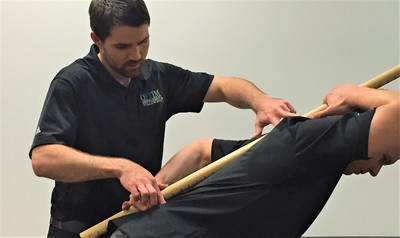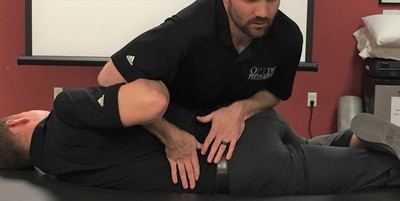- Home
- About Us
- TSPT Academy
- Online Courses
-
Resources
- Newsletter
- Business Minded Sports Physio Podcast
- Day in the Life of a Sports PT
- Residency Corner
-
Special Tests
>
-
Cervical Spine
>
- Alar Ligament Test
- Bakody's Sign
- Cervical Distraction Test
- Cervical Rotation Lateral Flexion Test
- Craniocervical Flexion Test (CCFT)
- Deep Neck Flexor Endurance Test
- Posterior-Anterior Segmental Mobility
- Segmental Mobility
- Sharp-Purser Test
- Spurling's Maneuver
- Transverse Ligament Test
- ULNT - Median
- ULNT - Radial
- ULNT - Ulnar
- Vertebral Artery Test
- Thoracic Spine >
-
Lumbar Spine/Sacroiliac Joint
>
- Active Sit-Up Test
- Alternate Gillet Test
- Crossed Straight Leg Raise Test
- Extensor Endurance Test
- FABER Test
- Fortin's Sign
- Gaenslen Test
- Gillet Test
- Gower's Sign
- Lumbar Quadrant Test
- POSH Test
- Posteroanterior Mobility
- Prone Knee Bend Test
- Prone Instability Test
- Resisted Abduction Test
- Sacral Clearing Test
- Seated Forward Flexion Test
- SIJ Compression/Distraction Test
- Slump Test
- Sphinx Test
- Spine Rotators & Multifidus Test
- Squish Test
- Standing Forward Flexion Test
- Straight Leg Raise Test
- Supine to Long Sit Test
-
Shoulder
>
- Active Compression Test
- Anterior Apprehension
- Biceps Load Test II
- Drop Arm Sign
- External Rotation Lag Sign
- Hawkins-Kennedy Impingement Sign
- Horizontal Adduction Test
- Internal Rotation Lag Sign
- Jobe Test
- Ludington's Test
- Neer Test
- Painful Arc Sign
- Pronated Load Test
- Resisted Supination External Rotation Test
- Speed's Test
- Posterior Apprehension
- Sulcus Sign
- Thoracic Outlet Tests >
- Yergason's Test
- Elbow >
- Wrist/Hand >
- Hip >
- Knee >
- Foot/Ankle >
-
Cervical Spine
>
- I want Financial Freedom
- I want Professional Growth
- I want Clinical Mastery
SIJ Compression/Distraction Test
Purpose: To assess for sacroiliac contributions to the patient's symptoms. SIJ Compression/Distraction are often separated into two different tests
Test Position: Supine.
Performing the Test: The examiner is standing at the side of the patient. Examiner crosses arms and places them at the medial aspects of the patients ASIS's. A gapping pressure is applied in an outward direction bilaterally and simultaneously. The examiner then uncrosses his/her arms and places his/her hands on the iliac crests to apply an inward/downward force. Pain indicates a positive test.
Diagnostic Accuracy: Compression: Sensitivity: .69; Specificity: .69. Distraction: Sensitivity: .60; Specificity: .81 ("Diagnosis of sacroiliac joint pain: validity of individual provocation tests and composites of tests").
Importance of Test: The gapping pressure gaps takes pressures off (or gaps) the anterior side of the SI joint and compresses the posterior side of the joint. The compression force takes pressure off (or gaps) the posterior side of the SI joint and compresses the anterior side of the joint. Because the joint places pressure off different areas of the joint, a pain reproduction can lead to the thought process of SI involvement to the patient's symptoms. Whether one force or the other produces the pain should not guide your treatment plan. It is important to remember that this test alone does not have high diagnostic accuracy and should be clustered with other tests (check out the Lumbar Spine/Sacroiliac Joint Homepage!).
Note: tests should only be performed by a properly trained health care practitioner.
Test Position: Supine.
Performing the Test: The examiner is standing at the side of the patient. Examiner crosses arms and places them at the medial aspects of the patients ASIS's. A gapping pressure is applied in an outward direction bilaterally and simultaneously. The examiner then uncrosses his/her arms and places his/her hands on the iliac crests to apply an inward/downward force. Pain indicates a positive test.
Diagnostic Accuracy: Compression: Sensitivity: .69; Specificity: .69. Distraction: Sensitivity: .60; Specificity: .81 ("Diagnosis of sacroiliac joint pain: validity of individual provocation tests and composites of tests").
Importance of Test: The gapping pressure gaps takes pressures off (or gaps) the anterior side of the SI joint and compresses the posterior side of the joint. The compression force takes pressure off (or gaps) the posterior side of the SI joint and compresses the anterior side of the joint. Because the joint places pressure off different areas of the joint, a pain reproduction can lead to the thought process of SI involvement to the patient's symptoms. Whether one force or the other produces the pain should not guide your treatment plan. It is important to remember that this test alone does not have high diagnostic accuracy and should be clustered with other tests (check out the Lumbar Spine/Sacroiliac Joint Homepage!).
Note: tests should only be performed by a properly trained health care practitioner.
References:
Laslett M, Aprill CN, McDonald B, Young SB. "Diagnosis of sacroiliac joint pain: validity of individual provocation tests and composites of tests." Man Ther. 2005 Aug;10(3):207-18. Web. 08/22/12.
Laslett M, Aprill CN, McDonald B, Young SB. "Diagnosis of sacroiliac joint pain: validity of individual provocation tests and composites of tests." Man Ther. 2005 Aug;10(3):207-18. Web. 08/22/12.
Copyright © The Student Physical Therapist LLC 2023




